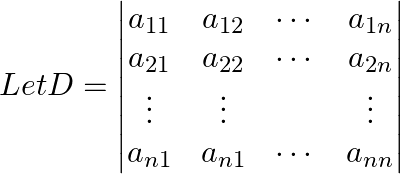Solution:
According to the question it is given that, ![]()
And ![]()
Assume there be a system of n simultaneous linear equations and with ‘n’ unknown given by
![]()
![]()
![]()
 Let
Let ![]() be the determinant obtained from D after replacing the
be the determinant obtained from D after replacing the ![]() column by
column by
![]() Then,
Then,
![]() provided that
provided that ![]()
Now, here we have
![]()
![]()
So by comparing with the theorem, let’s find ![]()
 Solving for the determinant, expanding along 1st row
Solving for the determinant, expanding along 1st row
![]()
![]()
⇒ ![]()

Solving for the determinant, expanding along 1st row
⇒ D2 = 2(6) – (17) (3)
⇒ D2 = 12 – 51
⇒ D2 = – 39
So, by Cramer’s Rule, we will get
![]()
![]()
![]()
And
![]()
![]()
![]()
